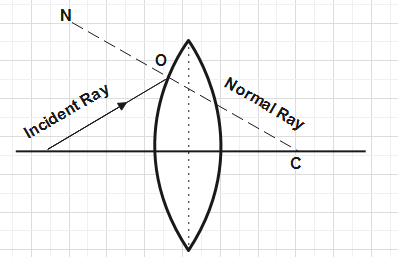
What is the normal ray in a convex lens at a given point?
Answer
498.6k+ views
Hint : In this question we have to find the point on the convex lens where normal ray passes, it is that point of the convex lens whose distance from optical centre is two times of radius of curvature of the lens, and normal ray always passes through this point whenever ray diagram formation of lenses is done.
Complete step-by-step solution:
In optics normal ray is ray along which when light passes then light remains undeviated either in mirror or lenses .Whenever light ray goes along this ray they never deviate from its path in mirror they bounces back along the same line and when it goes in lens these ray straight without any bending of light.
On a curved surface either of mirror or lens.
Normal ray always passes through a point called the centre of curvature.

Centre of curvature is a point whose distance from the optical centre is two times the radius of that curvature. It is defined as the reflecting or refracting surface of a spherical mirror or lens from a part of a sphere. It has a centre, which is known as centre of curvature.
A lens, either a convex lens or a concave lens has two spherical surfaces. Each of these surfaces forms a part of the sphere. The centre of these two spheres are called centre of curvature
Let \[R\] is representing the distance of radius of curvature
so \[2R\] is the distance between the optical centre and centre of curvature.
In the given figure, the point where the incident ray and normal ray intersect each other at point is called point of incidence.
If the surface is plane like glass then the normal ray is perpendicular to that surface and if the surface is curved then it also perpendicular to that surface.
So we conclude that the Normal ray in a convex lens passes at a point called centre of curvature and this diagram is representing the normal ray for a convex lens.
Note: Refraction is due to change in the speed of light as it enters from one transparent medium to another. Speed of light DECREASES as the beam of light travels from the rarer medium to the denser medium. Speed of light INCREASES as the beam of light travels from denser medium to the rarer medium.
Complete step-by-step solution:
In optics normal ray is ray along which when light passes then light remains undeviated either in mirror or lenses .Whenever light ray goes along this ray they never deviate from its path in mirror they bounces back along the same line and when it goes in lens these ray straight without any bending of light.
On a curved surface either of mirror or lens.
Normal ray always passes through a point called the centre of curvature.

Centre of curvature is a point whose distance from the optical centre is two times the radius of that curvature. It is defined as the reflecting or refracting surface of a spherical mirror or lens from a part of a sphere. It has a centre, which is known as centre of curvature.
A lens, either a convex lens or a concave lens has two spherical surfaces. Each of these surfaces forms a part of the sphere. The centre of these two spheres are called centre of curvature
Let \[R\] is representing the distance of radius of curvature
so \[2R\] is the distance between the optical centre and centre of curvature.
In the given figure, the point where the incident ray and normal ray intersect each other at point is called point of incidence.
If the surface is plane like glass then the normal ray is perpendicular to that surface and if the surface is curved then it also perpendicular to that surface.
So we conclude that the Normal ray in a convex lens passes at a point called centre of curvature and this diagram is representing the normal ray for a convex lens.
Note: Refraction is due to change in the speed of light as it enters from one transparent medium to another. Speed of light DECREASES as the beam of light travels from the rarer medium to the denser medium. Speed of light INCREASES as the beam of light travels from denser medium to the rarer medium.
Recently Updated Pages
A man running at a speed 5 ms is viewed in the side class 12 physics CBSE

The number of solutions in x in 02pi for which sqrt class 12 maths CBSE

State and explain Hardy Weinbergs Principle class 12 biology CBSE

Write any two methods of preparation of phenol Give class 12 chemistry CBSE

Which of the following statements is wrong a Amnion class 12 biology CBSE

Differentiate between action potential and resting class 12 biology CBSE

Trending doubts
What are the major means of transport Explain each class 12 social science CBSE

Which are the Top 10 Largest Countries of the World?

Draw a labelled sketch of the human eye class 12 physics CBSE

How much time does it take to bleed after eating p class 12 biology CBSE

Explain sex determination in humans with line diag class 12 biology CBSE

When was the first election held in India a 194748 class 12 sst CBSE




